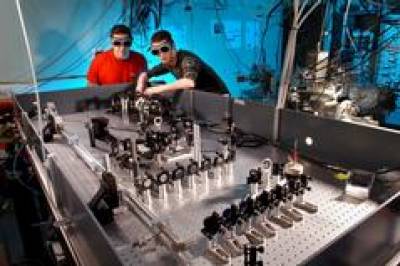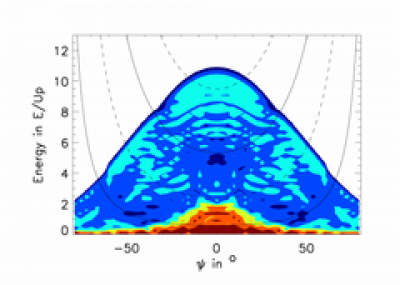Ultrafast laser spectroscopy and Strong Laser Interactions
| Dr Angus Bain | ||
| Dr Carla Figueira de Morisson Faria | Prof Jonathan Tennyson | Dr Agapi Emmanouilidou |
Femtosecond laser pulses, with durations of the order 10-15 s, provide us with a very powerful tool for examining atomic and molecular processes. In particular, their short temporal duration allows us to use pump-probe techniques to watch atomic and molecular processes in a time-resolved fashion. Furthermore, the high laser intensities that can be achieved with short laser pulses allows us to study the interaction of atoms and molecules with strong laser fields, opening the door to a new class of physics where measurements on the attosecond (10-18 s) timescale become possible.

Through careful control over the time delay between laser pulses interacting with the system under study, we are able to use lasers to make snapshots of the dynamics of quantum mechanical systems. For example, Angus Bain is developing and applying novel time-resolved polarised laser techniques to study and control molecular dynamics in ordered molecular materials, biological systems and single molecules. In ongoing work, new polarised optical techniques will be developed for the preparation of virtual crystalline arrays of biomolecules for the investigation of local protein structure and dynamics.

When atoms and molecules are exposed to extremely strong laser fields novel and exciting processes can take place. At UCL we have an ongoing program of experimental and theoretical work studying these processes such as above threshold ionization, high-order harmonic generation, electron recollision, and non-sequential double ionization. In recent years, understanding these processes has led to the possibility of using ultrashort laser pulses to image molecular processes on the attosecond timescale and the angstrom length scale simultaneously. The theory underpinning our understanding of these processes is being actively developed by Carla Faria and Jonathan Tennyson is extending R-matrix methods to apply to these problems. Roy Newell and Jonathan Underwood have ongoing experimental programs examining these processes.
Strong laser fields also offer us the possibility of controlling molecular processes, and we have ongoing work examining the use of shaped laser pulses for the control of molecular orientation, and also molecular photochemistry. This work, which is concerned with control over quantum wavepackets has applications in single molecule imaging, quantum information processing.
 Close
Close

